On Occupant Behavior and Innovation Studies Towards High Performance Buildings: A Transdisciplinary Approach
Abstract
1. Introduction
2. Literature Review
2.1. Overview of the Behavior Science for Energy Efficiency in Buildings
2.1.1. Economic Approaches
2.1.2. Psychological Approaches
2.1.3. Sociological Approaches
2.1.4. Integrated Approaches
2.2. Overview of the Innovation Studies for Energy Efficiency in Building
2.2.1. Diffusion Theory
2.2.2. Social Practice Theory
2.2.3. Technology Acceptance Model
3. Network Analysis of Key Concepts and Visualization of Interdisciplinary Dialog
3.1. Method for Network Analysis
3.2. The Analysis
3.3. A Leaner View of Interdisciplinary Dialog
4. Discussion
4.1. Influences of Behavior Studies to Innovation Studies
4.2. Influencess of Innovation studies to Behavior Research
5. Potential Benefits of Interdisciplinary Dialog for Smart Thermostats
5.1. Perspectives of Behavior and Innovation Studies for Thermostats
5.2. Thermostats as an Example of Interdisciplinary Dialog between Behavior and Innovation Studies
5.3. STC Applied to Thermostats
6. Concluding Remarks
6.1. Discussions
6.2. Future Work
Supplementary Materials
Author Contributions
Funding
Acknowledgments
Conflicts of Interest
Appendix A. Steps Followed while Creating Original Dataset and Visualizing Network Analysis
AND
TITLE: (efficien* OR saving* OR reduction OR consum* OR use* OR demand)
AND
TITLE: (building* OR house* OR home OR residential OR non-residential OR office OR commercial)
AND
TOPIC: (behavio* OR socio* OR social OR pro-environmental OR pro-social OR eco-* OR habit OR occupa* OR culture OR theor* OR model OR learning OR practice OR network OR motivation OR lifestyle OR responsibility OR interpersonal)
AND
TOPIC: (innovati* OR adattion OR adoption OR diffusion OR acceptance OR social practice OR barrier* OR driver* OR transition* OR niche OR technolog*)
NOT
TOPIC: (renewable* OR PV OR photovoltaic OR wind)
- If a term belongs to theoretical core of the one of the behavior or innovation theories, it is assigned to the category of corresponding literature (e.g., the term ‘diffusion’ is assigned to innovation studies category),
- If a term is specifically discussed in reviews of one of the behavior or innovation literature but not discussed in the other, the term is assigned to one that discusses it (e.g., SPT is assigned to behavior literature),
- If it is clear that a term is more frequently used by one of the candidate literature, it is assigned to that category (e.g., the terms ‘attitude’ and ‘norm’ is assigned to behavior studies category)
- If a term is frequently used by both research fields, it is assigned to commons category (as the term ‘barriers’ is assigned to commons category).
| Energy Fuels |
|---|
| Construction Building Technology |
| Social Sciences Interdisciplinary |
| Engineering Civil |
| Environmental Sciences |
| Environmental Studies |
| Multidisciplinary Sciences |
| Green Sustainable Science Technology |
| Economics |
| Planning Development |
| Engineering Electrical Electronic |
| Engineering Environmental |
| Thermodynamics |
| Business Finance |
| Computer Science Information Systems |
| Engineering Mechanical |
| Sociology |
| Computer Science Interdisciplinary Applications |
| Engineering Industrial |
| Architecture |
| Automation Control Systems |
| Psychology |
| Psychology Applied |
| Management |
| Psychology Multidisciplinary |
| Business |
| Operations Research Management Science |
| Ecology |
| Philosophy |
| Engineering Multidisciplinary |
| Political Science |
| Social Issues |
References
- United Nations, Department of Economic and Social Affairs, Population Division. World Urbanization Prospects: The 2014 Revision, Highlights (ST/ESA/SER.A/352). 2014. Available online: https://www.un.org/en/development/desa/publications/2014-revision-world-urbanization-prospects.html (accessed on 27 July 2018).
- International Energy Agency (IEA). World Energy Outlook 2015; OECD/IEA: Paris, France, 2015; Available online: https://www.iea.org/newsroom/news/2015/november/world-energy-outlook-2015.html (accessed on 23 July 2018).
- International Energy Agency (IEA). Market Trends and Medium-Term Prospects 2015; OECD/IEA: Paris, France, 2015; Available online: https://www.iea.org/publications/freepublications/publication/MediumTermEnergyefficiencyMarketReport2015.pdf (accessed on 23 July 2018).
- International Energy Agency (IEA). Perspectives for the Energy Transition: The Role of Energy Efficiency 2018; OECD/IEA: Paris France, 2018; Available online: https://webstore.iea.org/perspectives-for-the-energy-transition-investment-needs-for-a-low-carbon-energy-system.pdf (accessed on 12 July 2018).
- U.S. Energy Information Administration. Experts Meeting: Behavioral Economics as Applied to Energy Demand Analysis and Energy Efficiency Programs. July 17, 2013; U.S. Energy Information Administration: Washington, DC, USA, 2013. Available online: https://www.eia.gov/outlooks/aeo/workinggroup/buildings/workshop/behavior/pdf/behavior_economics_ee.pdf (accessed on 19 June 2018).
- Stern, P.C. Individual and household interactions with energy systems: Toward integrated understanding. Energy Res. Soc. Sci. 2014, 1, 41–48. [Google Scholar] [CrossRef]
- Yan, D.; Hong, T.; Dong, B.; Mahdavi, A.; D’Oca, S.; Gaetani, I.; Feng, X. IEA EBC Annex 66: Definition and simulation of occupant behavior in buildings. Energy Build. 2017, 156, 258–270. [Google Scholar] [CrossRef]
- Ozaki, R. Adopting sustainable innovation: What makes consumers sign up to green electricity? Bus. Strateg. Environ. 2011, 20, 1–17. [Google Scholar] [CrossRef]
- Jackson, T. Motivating Sustainable Consumption: A review of evidence on consumer behavior and behavioral change. A report to the Sustainable Development Research Network. Guildf. Surrey 2005, 15, 1027–1051. Available online: http://sustainablelifestyles.ac.uk/sites/default/files/motivating_sc_final.pdf (accessed on 29 June 2018).
- Hong, T.; Yan, D.; D’Oca, S.; Chen, C. Ten questions concerning occupant behavior in buildings: The big picture. Build. Environ. 2017, 114, 518–530. [Google Scholar] [CrossRef]
- Fagerberg, J.; Verspagen, B. Innovation studies—The emerging structure of a new scientific field. Res. Policy 2009, 38, 218–233. [Google Scholar] [CrossRef]
- Karakaya, E.; Hidalgo, A.; Nuur, C. Diffusion of eco-innovations: A review. Renew. Sustain. Energy Rev. 2014, 33, 392–399. [Google Scholar] [CrossRef]
- Stephenson, J.; Barton, B.; Carrington, G.; Gnoth, D.; Lawson, R.; Thorsnes, P. Energy cultures: A framework for understanding energy behaviours. Energy Policy 2010, 38, 6120–6129. [Google Scholar] [CrossRef]
- Wisdom, J.P.; Chor, K.H.B.; Hoagwood, K.E.; Horwitz, S.M. Innovation adoption: A review of theories and constructs. Adm. Policy Ment. Health Ment. Health Serv. Res. 2014, 41, 480–502. [Google Scholar] [CrossRef] [PubMed]
- Rennings, K. Redefining innovation—Eco-innovation research and the contribution from ecological economics. Ecol. Econ. 2000, 32, 319–332. [Google Scholar] [CrossRef]
- NRC (National Research Council). Convergence: Facilitating Transdisciplinary Integration of Life Sciences, Physical Sciences, Engineering, and beyond; The National Academies Press: Washington, DC, USA, 2014. [Google Scholar] [CrossRef]
- Wolfe, A.K.; Malone, E.L.; Heerwagen, J.; Dion, J. Behavioral Change and Building Performance: Strategies for Significant, Persistent, and Measurable Institutional Change; A Report to U.S. Department of Energy by Pacific Northwest National Laboratory; Pacific Northwest National Laboratory: Richland, WA, USA, 2014. Available online: https://www.energy.gov/sites/prod/files/2014/06/f16/change_performance.pdf (accessed on 9 September 2018).
- Farley, K.; Mazur-Stommen, S. Saving Energy with Neighborly Behavior: Energy Efficiency for Multifamily Renters and Homebuyers; ACEEE White Pap.; ACEEE: Washington, DC, USA, May 2014; Available online: https://aceee.org/files/pdf/white-paper/saving-energy-with-neighborly-behavior.pdf (accessed on 9 September 2018).
- Lutzenhiser, L. Social and behavioral aspects of energy use. Annu. Rev. Energy Environ. 1993, 18, 247–289. [Google Scholar] [CrossRef]
- Ghasemi, M. Behavior Related Energy Use in Single-Family Homes—A Study on Residential Houses in Sweden. Master’ s Thesis, KTH School of Industrial Engineering and Management, Stocholm, Sweden, 2014. Available online: https://kth.diva-portal.org/smash/record.jsf?pid=diva2%3A864065&dswid=2716 (accessed on 10 September 2018).
- Wilson, C.; Dowlatabadi, H. Models of decision making and residential energy use. Annu. Rev. Environ. Resour. 2007, 32, 169–203. [Google Scholar] [CrossRef]
- Karatasou, S.; Laskari, M.; Santamouris, M. Models of behavior change and residential energy use: A review of research directions and findings for behavior-based energy efficiency. Adv. Build. Energy Res. 2014, 8, 137–147. [Google Scholar] [CrossRef]
- Lutzenhiser, L. Overview of the Behavior, Energy and Climate Change Conference Keynote Address “Setting the Stage: Why Behavior Is Important” for California Senate Legislation Development Related to a California Climate Change Research Institute. Available online: https://web.stanford.edu/group/peec/cgi-bin/docs/events/2007/becc/presentations/0T-Setting%20the%20Stage%20-%20Why%20 Behavior %20is%20Important%20(Presentation%20Summary).pdf (accessed on 12 July 2018).
- Faiers, A.; Cook, M.; Neame, C. Towards a contemporary approach for understanding consumer behavior in the context of domestic energy use. Energy Policy 2007, 35, 4381–4390. [Google Scholar] [CrossRef]
- Horta, A.; Wilhite, H.; Schmidt, L.; Bartiaux, F. Socio-technical and cultural approaches to energy consumption: An introduction. Nat. Cult. 2014, 9, 115–121. [Google Scholar] [CrossRef]
- Elster, J. Rational Choice: Readings in Social and Political Theory, 1st ed.; New York University Press: New York, NY, USA, 1986; ISBN 0-8147-2168-0. [Google Scholar]
- Thaler, R.H. Mental Accounting and Consumer Choice. Mark. Sci. 2008, 27, 15–25. [Google Scholar] [CrossRef]
- Becker, G. The Economic way of Looking at Life; Coase-Sandor Institute for Law & Economics Working Paper No. 12; Coase-Sandor Institute for Law & Economics: Chicago, IL, USA, 1993. [Google Scholar]
- Energy Information Agency. Behavioral Economics Applied to Energy Demand Analysis: A Foundation; Energy Information Agency: Washington, DC, USA, 2014. Available online: https://www.eia.gov/analysis/studies/demand/economicbehavior/ pdf/behavioraleconomics.pdf (accessed on 23 July 2018).
- Abrahamse, W.; Steg, L.; Vlek, C.; Rothengatter, T. A review of intervention studies aimed at household energy conservation. J. Environ. Psychol. 2005, 25, 273–291. [Google Scholar] [CrossRef]
- Al-Sukri, M.N.; Al-Kharusi, R.M. Ajzen and Fishbein’s Theory of Reasoned Action (TRA). In Information Seeking Behavior and Technology Adoption: Theories and Trends, 1st ed.; IGI Global: Hershey, PA, USA, 2015. [Google Scholar]
- Kollmuss, A.; Agyeman, J. Mind the gap: Why do people behave environmentally and what are the barriers to pro-environmental behavior. Environ. Educ. Res. 2002, 8, 239–260. [Google Scholar] [CrossRef]
- Ajzen, I. The theory of planned behavior. Organ. Behav. Hum. Decis. Process. 1991, 50, 179–211. [Google Scholar] [CrossRef]
- Chen, M.F. Extending the theory of planned behavior model to explain people’s energy savings and carbon reduction behavioral intentions to mitigate climate change in Taiwan-moral obligation matters. J. Clean. Prod. 2016, 112, 1746–1753. [Google Scholar] [CrossRef]
- Zierler, R.; Wehrmeyer, W.; Murphy, R. The energy efficiency behavior of individuals in large organisations: A case study of a major UK infrastructure operator. Energy Policy 2017, 104, 38–49. [Google Scholar] [CrossRef]
- Park, E.; Kwon, SJ. What motivations drive sustainable energy-saving behavior?: An examination in South Korea. Sustain. Energy Rev. 2017, 79, 494–502. [Google Scholar] [CrossRef]
- Stern, P.C. New environmental theories: Toward a coherent theory of environmentally significant behavior. J. Soc. Issues 2000, 56, 407–424. [Google Scholar] [CrossRef]
- Bandura, A. Social Learning Theory, 1st ed.; Prentice-Hall: Upper Saddle River, NJ, USA, 1977; ISBN 0-13-816751-6. [Google Scholar]
- Pegels, A.; Figueroa, A.; Never, B. The Human Factor in Energy Efficiency: Lessons from Developing Countries; DEI: Bonn, Germany, 2015; Available online: https://www.die-gdi.de/uploads/media/The_Human_Factor_in_Energy_Efficiency_FINAL_LOW_RES.pdf (accessed on 25 July 2018).
- Shove, E. Converging conventions of comfort, cleanliness and convenience. J. Consum. Policy 2003, 26, 395–418. [Google Scholar] [CrossRef]
- Staddon, S.C.; Cycil, C.; Goulden, M.; Leygue, C.; Spencer, A. Intervening to change behavior and save energy in the workplace: A systematic review of available evidence. Energy Res. Soc. Sci. 2016, 17, 30–51. [Google Scholar] [CrossRef]
- Jensen, C.L. Understanding energy efficient lighting as an outcome of dynamics of social practices. J. Clean. Prod. 2017, 165, 1097–1106. [Google Scholar] [CrossRef]
- Liedtke, C.; Baedeker, C.; Hasselkuß, M.; Rohn, H.; Grinewitschus, V. User-integrated innovation in Sustainable LivingLabs: An experimental infrastructure for researching and developing sustainable product service systems. J. Clean. Prod. 2015, 97, 106–116. [Google Scholar] [CrossRef]
- Cordella, A.; Shaikh, M. Actor Network Theory and After: What’s New for IS Research? In Proceedings of the European Conference on Information Systems, Naples, Italy, 19–21 June 2003; Available online: https://personal.lse.ac.uk/shaikh/ANT%20ECIS%20FINAL%20VERSI ON%2031%20March.pdf (accessed on 20 July 2018).
- Keirstead, J. Evaluating the applicability of integrated domestic energy consumption frameworks in the UK. Energy Policy 2006, 34, 3065–3077. [Google Scholar] [CrossRef]
- Lutzenhiser, L. Innovation and organizational networks industry. Energy Policy 1994, 22, 867–876. [Google Scholar] [CrossRef]
- Anderson, K.; Asce, S.M.; Lee, S.; Asce, M.; Menassa, C. Impact of social network type and structure on modeling normative energy use behavior interventions. J. Comput. Civ. Eng. 2014, 28, 30–39. [Google Scholar] [CrossRef]
- Jalas, M.; Juntunen, J.K. Energy intensive lifestyles: Time use, the activity patterns of consumers, and related energy demands in Finland. Ecol. Econ. 2015, 113, 51–59. [Google Scholar] [CrossRef]
- Chatterton, T. An Introduction to Thinking About ‘Energy Behaviour’: A Multi-Model Approach; Department of Energy and Climate Change: London, UK, December 2011. Available online: http://www.decc.gov.uk/assets/decc/11/about-us/economics-social-research/3887-intro-thinking-energy-behaviours.pdf (accessed on 29 July 2018).
- Olander, F.; Thogersen, J. Understanding of consumer behaviour as a prerequisite for environmental protection. J. Consum. Policy 1995, 18, 345–385. [Google Scholar] [CrossRef]
- Sweeney, J.C.; Kresling, J.; Webb, D.; Soutar, G.N.; Mazzarol, T. Energy saving behaviours: Development of a practice-based model. Energy Policy 2013, 61, 371–381. [Google Scholar] [CrossRef]
- Godin, B. Innovation Studies: The Invention of a Specialty (Part II); Project on the Intellectual History of Innovation; Working Paper No. 8; INRS: Montreal, QC, Canada, 2010; Available online: http://www.csiic.ca/PDF/IntellectualNo8.pdf (accessed on 9 September 2018).
- Martin, B.R. The evolution of science policy and innovation studies. Res. Pol. 2012, 41, 1219–1239. [Google Scholar] [CrossRef]
- Rogers, E.M. Diffusion of Innovations, 4th ed.; The Free Press: New York, NY, USA, 1995; ISBN 0-02-874074-2. [Google Scholar]
- Bass, F.M. A new product growth for model consumer durables. Manag. Sci. 1969, 16, 215–227. [Google Scholar] [CrossRef]
- Lundvall, B. Innovation studies: A Personal interpretation of ‘The State of the Art’. In Innovation Studies: Evolution and future challenges; Oxford University Press: Oxford, UK, 2013; ISBN 978-0-19-968634-6. [Google Scholar]
- Darko, A.; Chan, A.P.C.; Ameyaw, E.E.; He, B.J.; Olanipekun, A.O. Examining issues influencing green building technologies adoption: The United States green building experts’ perspectives. Energy Build. 2017, 144, 320–332. [Google Scholar] [CrossRef]
- Noailly, J. Improving the energy efficiency of buildings: The impact of environmental policy on technological innovation. Energy Econ. 2012, 34, 795–806. [Google Scholar] [CrossRef]
- Diaz-Rainey, I.; Ashton, J.K. Investment inefficiency and the adoption of eco-innovations: The case of household energy efficiency technologies. Energy Policy 2015, 82, 105–117. [Google Scholar] [CrossRef]
- Mlecnik, E. Activating the adoption of innovation: Lessons from a passive house network. Built. Environ. Proj. Asset Manag. 2016, 6, 205–217. [Google Scholar] [CrossRef]
- Klein, S.J.W.; Coffey, S. Building a sustainable energy future, one community at a time. Sustain. Energy Rev. 2016, 60, 867–880. [Google Scholar] [CrossRef]
- Jalas, M.; Hyysalo, S.; Heiskanen, E. Everyday experimentation in energy transition: A practice-theoretical view. J. Clean. Prod. 2017, 169, 77–84. [Google Scholar] [CrossRef]
- Boerenfijn, P.; Kazak, J.K.; Schellen, L.; van Hoof, J. A multi-case study of innovations in energy performance of social housing for older adults in the Netherlands. Energy Build. 2018, 158, 1762–1769. [Google Scholar] [CrossRef]
- Gianfrate, V.; Piccardo, C.; Longo, D.; Giachetta, A. Rethinking social housing: Behavioural patterns and technological innovations. Sustain. Cities Soc. 2017, 33, 102–112. [Google Scholar] [CrossRef]
- Hansen, M.; Hauge, B. Prosumers and smart grid technologies in Denmark: Developing user competences in smart grid households. Energy Effic. 2017, 10, 1215–1234. [Google Scholar] [CrossRef]
- Morris, J.; Marzano, M.; Dandy, N.; O’Brien, L. Theories and Models of Behaviour and Behaviour Change. Forest Research, Theories: Behavior Change. 2012. Available online: https://www.forestresearch.gov.uk/documents/1409/behaviour_review_theory.pdf (accessed on 29 July 2018).
- Shove, E.; Pantzar, M.; Watson, M. The Dynamics of Social Practice—Everyday Life and How It Changes, 1st ed.; Sage: London, UK, 2012; ISBN 978–0-85702–042–0. [Google Scholar]
- Davis, F.D.; Bagozzi, R.P.; Warshaw, P.R. User acceptance of computer technology: A comparison of two theoretical models. Manag. Sci. 1989, 35, 982–1003. [Google Scholar] [CrossRef]
- Li, L. A Critical Review of Technology Acceptance Literature. 2010. Available online: http://www.swdsi.org/swdsi2010/SW2010_Preceedings/papers/PA104.pdf (accessed on 1 August 2018).
- Nielsen, J. Usability Engineering; Morgan Kaufmann: San Francisco, CA, USA, 1993; ISBN 1-12-518406-9. [Google Scholar]
- Park, E.-S.; Hwang, B.; Ko, K.; Kim, D. Consumer acceptance analysis of the home energy management system. Sustainability 2017, 9, 2351. [Google Scholar] [CrossRef]
- Chen, C.F.; Xu, X.; Arpan, L. Between the technology acceptance model and sustainable energy technology acceptance model: Investigating smart meter acceptance in the United States. Energy Res. Soc. Sci. 2017, 25, 93–104. [Google Scholar] [CrossRef]
- Web of Science. Available online: https://apps.webofknowledge.com (accessed on 5 April 2018).
- Sci2-Team. Science of Science (Sci2) Tool. Indiana University and SciTech Strategies. 2009. Available online: https://sci2.cns.iu.edu/user/index.php (accessed on 17 July 2018).
- Gaede, J.; Rowlands, I.H. Visualizing social acceptance research: A bibliometric review of the social acceptance literature for energy technology and fuels. Energy Res. Soc. Sci. 2018, 40, 142–158. [Google Scholar] [CrossRef]
- Mauser, W.; Klepper, G.; Rice, M. Transdisciplinary global change research: The co-creation of knowledge for sustainability. Environ. Sustain. 2013, 5, 420–431. [Google Scholar] [CrossRef]
- Ulli-Beer, S.A.; Bruppacher, S.; Grösser, S.N.; Geisshüsler, S.; Müller, M.; Mojtahedzadeh, M.; Schwaninger, M.; Ackermann, F.; Andersen, D.; Richardson, G.; et al. Understanding and accelerating the diffusion process of energy-efficient buildings: Introducing an action science venture. In Proceedings of the 24th International Conference of the System Dynamics Society, Nijmegen, The Netherlands, 23–27 July 2006; pp. 125–126. [Google Scholar]
- Armel, K.C. Behavior & Energy. Available online: https://web.stanford.edu/~kcarmel/pdf/Armel_Behavior_and_Energy_Presentation_with_Notes.pdf (accessed on 26 July 2018).
- Spreng, D. Transdisciplinary energy research—Reflecting the context. Energy Res. Soc. Sci. 2014, 1, 65–73. [Google Scholar] [CrossRef]
- Beretti, A.; Figuières, C.; Grolleau, G. Behavioral innovations: The missing capital in sustainable development? Ecol. Econ. 2013, 89, 187–195. [Google Scholar] [CrossRef]
- Sovacool, B.K.; Ryan, S.E.; Stern, P.C.; Jandad, K.; Rochline, G.; Sprengf, D.; Pasqualettig, M.J.; Wilhiteh, H.; Lutzenhiser, L. Integrating social science in energy research. Energy Res. Soc. Sci. 2015, 6, 95–99. [Google Scholar] [CrossRef]
- Venkatachalam, L. Behavioral economics for environmental policy. Ecol. Econ. 2008, 7, 4–9. [Google Scholar] [CrossRef]
- Jaffe, A.B.; Stavins, R.N. The energy-efficiency gap: What does it mean? Energy Policy 1994, 22, 804–810. [Google Scholar] [CrossRef]
- Nair, G.; Gustavsson, L.; Mahapatra, K. Factors influencing energy efficiency investments in existing Swedish residential buildings. Energy Policy 2010, 38, 2956–2963. [Google Scholar] [CrossRef]
- Noonan, D.S.; Hsieh, L.H.C.; Matisoff, D. Economic, sociological, and neighbor dimensions of energy efficiency adoption behaviors: Evidence from the U.S residential heating and air conditioning market. Energy Res. Soc. Sci. 2015, 10, 102–113. [Google Scholar] [CrossRef]
- Stern, P.C. How can social science research become more influential in energy transitions? Energy Res. Soc. Sci. 2017, 26, 91–95. [Google Scholar] [CrossRef]
- Shen, L. Human-Building Interaction (HBI): Design thinking And Energy Efficiency; Center for Energy and Environment: Minneapolis, MN, USA, 2015. [Google Scholar]
- Sussman, R.; Gifford, R.; Abrahamse, W. Social Mobilization: How to Encourage Action on Climate Change; Pasific Institute Climate Change: Victoria, New Zealand, 2016. [Google Scholar]
- Ahmad, M.W.; Mourshed, M.; Mundow, D.; Sisinni, M.; Rezgui, Y. Building energy metering and environmental monitoring—A state-of-the-art review and directions for future research. Energy Build. 2016, 120, 85–102. [Google Scholar] [CrossRef]
- Meier, A.; Aragon, C.; Peffer, T.; Perry, D.; Pritoni, M. Usability of residential thermostats: Preliminary investigations. Build. Environ. 2011, 46, 1891–1898. [Google Scholar] [CrossRef]
- Ramos, A.; Gago, A.; Labandeira, X.; Linares, P. The role of information for energy efficiency in the residential sector. Energy Econ. 2015, 52, S17–S29. [Google Scholar] [CrossRef]
- Foster, D.; Lawson, S.; Blythe, M.; Cairns, P.; Pool, B. Wattsup?: Motivating reductions in domestic energy consumption using social networks. In Proceedings of the NordiCHI 2010, Reykjavik, Iceland, 16–20 October 2010; ISBN 978-1-60558-934-3. [Google Scholar]
- AlSkaif, T.; Lampropoulos, I.; van den Broek, M.; van Sark, W. Gamification-based framework for engagement of residential customers in energy applications. Energy Res. Soc. Sci. 2017, 44, 187–195. [Google Scholar] [CrossRef]
- Kejriwal, S.; Mahajan, S. Smart Buildings: How IoT Technology Aims to Add Value for Real Estate Companies; Deloitte Univ. Press: London, UK, 2016; Available online: http://www2.deloitte.com/us/en/pages/technology-media-and-telecommunications/topics/the-internet-of-things.html (accessed on 23 July 2018).
- Brager, G.S.; Zhang, H.; Arens, E. Evolving opportunities for providing thermal comfort. Build. Res. Inf. 2015, 43, 274–287. [Google Scholar] [CrossRef]
- D’Oca, S.; Chen, C.F.; Hong, T.; Belafi, Z. Synthesizing building physics with social psychology: An interdisciplinary framework for context and occupant behavior in office buildings. Energy Res. Soc. Sci. 2017, 34, 240–251. [Google Scholar] [CrossRef]
- Lee, Y.; Malkawi, A. Simulating human behavior: An agent-based modeling approach. In Proceedings of the 13th Conference International Build Perform Simulation Association, Le Bourget Du Lac, France, 25–30 August 2013; pp. 3184–3191. Available online: http://www.ibpsa.org/proceedings/BS2013/p_2464.pdf (accessed on 23 July 2018).
- Gillingham, K.; Newell, R.G.; Palmer, K. Energy Efficiency Economics and Policy. Annu. Rev. Resour. Econ. 2009, 1, 597–620. [Google Scholar] [CrossRef]
- Wilhite, H. New thinking on the agentive relationship between end-use technologies and energy-using practices. Energy Effic. 2008, 1, 121–130. [Google Scholar] [CrossRef]
- Lu, Y.; Zhang, N.; Chen, J. A behavior-based decision-making model for energy performance contracting in building retrofit. Energy Build. 2017, 156, 315–326. [Google Scholar] [CrossRef]
- Kivimaa, P.; Martiskainen, M. Innovation, low energy buildings and intermediaries in Europe: Systematic case study review. Energy Effic. 2018, 11, 31–51. [Google Scholar] [CrossRef]
- Lai, X.; Liu, J.; Shi, Q.; Georgiev, G.; Wu, G. Driving forces for low carbon technology innovation in the building industry: A critical review. Sustain. Energy Rev. 2017, 74, 299–315. [Google Scholar] [CrossRef]
- Theodorakopoulos, N.; Bennett, D.; Sanchez, D. Intermediation for technology diffusion and user innovation in a developing rural economy: A social learning perspective. Entrep. Reg. Dev. 2014, 26, 645–662. [Google Scholar] [CrossRef]
- Kuckshinrichs, W.; Kronenberg, T.; Hansen, P. The social return on investment in the energy efficiency of buildings in Germany. Energy Policy 2010, 38, 4317–4329. [Google Scholar] [CrossRef]
- Ohnmacht, T.; Schaffner, D.; Weibel, C.; Schad, H. Rethinking social psychology and intervention design: A model of energy savings and human behavior. Energy Res. Soc. Sci. 2017, 26, 40–53. [Google Scholar] [CrossRef]
- Pentland, A. Social Physics; The Penguin Press: New York, NY, USA, 2014; ISBN 978-1-101-62557-6. [Google Scholar]
- Zhou, K.; Yang, S. Understanding household energy consumption behavior: The contribution of energy big data analytics. Sustain. Energy Rev. 2016, 56, 810–819. [Google Scholar] [CrossRef]
- Yeatts, D.E.; Auden, D.; Cooksey, C.; Chen, C.F. A systematic review of strategies for overcoming the barriers to energy-efficient technologies in buildings. Energy Res. Soc. Sci. 2017, 32, 76–85. [Google Scholar] [CrossRef]
- Schleich, J.; Gruber, E. Beyond case studies: Barriers to energy efficiency in commerce and the services sector. Energy Econ. 2008, 30, 449–464. [Google Scholar] [CrossRef]
- Jensen, T.; Holtz, G.; Chappin, É.J.L. Agent-based assessment framework for behavior-changing feedback devices: Spreading of devices and heating behavior. Technol. Forecast. Soc. Chang. 2015, 98, 105–119. [Google Scholar] [CrossRef]
- Roberts, E.B. Thomas Tredgold, CIBSE Heritage Group. Available online: http://www.hevac-heritage.org/biographies/tredgold/tredgold.pdf (accessed on 6 September 2018).
- Park, J.Y.; Nagy, Z. Comprehensive analysis of the relationship between thermal comfort and building control research—A data-driven literature review. Sustain. Energy Rev. 2018, 82, 2664–2679. [Google Scholar] [CrossRef]
- Pritoni, M.; Woolley, J.M.; Modera, M.P. Do occupancy-responsive learning thermostats save energy? A field study in university residence halls. Energy Build. 2016, 127, 469–478. [Google Scholar] [CrossRef]
- Blanchard, J. Guest Room HVAC Occupancy-Based Control Technology Demonstration; U.S. Department of Energy: Washington, DC, USA, September 2012. Available online: https://www1.eere.energy.gov/buildings/publications/pdfs/alliances/creea_guest_room_occupancy-based_controls_report.pdf (accessed on 12 July 2018).
- Krill, W. Pacific Gas and Electric Company Emerging Technologies Program Application Assessment Report #0825 Occupancy-Based Guestroom Controls Study Issued. 2007. Available online: https://www.etcc-ca.com/sites/default/files/OLD/images/stories/etcc_report_368.pdf (accessed on 18 July 2018).
- Shann, M.; Alan, A.; Seuken, S.; Costanza, E.; Ramchurn, S.D. Save Money or Feel Cozy?: A field experiment evaluation of a smart thermostat that learns heating preferences. In Proceedings of the 16th Conference Autonomous Agents Multi-Agent Systems, São Paulo, Brazil, 8–12 May 2017; pp. 1008–1016. Available online: http://dl.acm.org/citation.cfm?id=3091210.3091268 (accessed on 23 July 2018).
- Oldewurtel, F.; Parisio, A.; Jones, C.N.; Gyalistras, D.; Gwerder, M.; Stauch, V.; Lehmann, B.; Morari, M. Increasing energy efficiency in building climate control using weather forecasts and model predictive control. Energy Build. 2011, 45, 15–27. [Google Scholar] [CrossRef]
- Huchuk, B.; O’Brien, W.; Sanner, S. A longitudinal study of thermostat behaviors based on climate, seasonal, and energy price considerations using connected thermostat data. Build. Environ. 2018, 139, 199–210. [Google Scholar] [CrossRef]
- Apex Analytics LLC. Energy Trust of Oregon Smart thermostat Pilot Evaluation; Apex Analytics LLC: Boulder, CO, USA, 2016; Available online: http://assets.energytrust.org/api/assets/reports/Smart_Thermostat_Pilot_Evaluation-Final_wSR.pdf (accessed on 19 July 2018).
- Urban, B.; Gomez, C. A Case for Thermostat User Models. In Proceedings of the 13th Conference International Build Perform Simulation Association, Chambéry, France, 26–28 August 2012; pp. 1483–1490. [Google Scholar]
- Peffer, T.; Pritoni, M.; Meier, A.; Aragon, C.; Perry, D. How people use thermostats in homes: A review. Build. Environ. 2011, 46, 2529–2541. [Google Scholar] [CrossRef]
- Abrahamse, W.; Steg, L.; Vlek, C.; Rothengatter, T. The effect of tailored information, goal setting, and tailored feedback on household energy use, energy-related behaviors, and behavioral antecedents. J. Environ. Psychol. 2007, 27, 265–276. [Google Scholar] [CrossRef]
- Santin, O.G. Behavioural patterns and user profiles related to energy consumption for heating. Energy Build. 2011, 43, 2662–2672. [Google Scholar] [CrossRef]
- Gram-Hanssen, K. Residential heat comfort practices: Understanding users. Build. Res. Inf. 2010, 38, 175–186. [Google Scholar] [CrossRef]
- Van Raaij, F.; Verhallen, T.M.M. A behavioral model of residential energy use. J. Econ. Psychol. 1983, 3, 39–63. [Google Scholar] [CrossRef]
- Karjalainen, S. Usability guidelines for room temperature controls. Intell. Build. Int. 2010, 2, 85–97. [Google Scholar] [CrossRef]
- Wall, S.; Healy, F. Usability Testing of Smarter Heating Controls; A report to the Department for Energy and Climate Change; Energy and Climate Change: London, UK, 2013. Available online: https://assets.publishing.service.gov.uk/government/uploads/system/uploads/attachment_data/file/266220/usability_testing_smarter_heating_controls.pdf (accessed on 3 August 2018).
- Pritoni, M.; Meier, A.K.; Aragon, C.; Perry, D.; Peffer, T. Energy efficiency and the misuse of programmable thermostats: The effectiveness of crowdsourcing for understanding household behavior. Energy Res. Soc. Sci. 2015, 8, 190–197. [Google Scholar] [CrossRef]
- Goldbach, K.; Rotaru, A.M.; Reichert, S.; Stiff, G.; Gölz, S. Which digital energy services improve energy efficiency? A multi-criteria investigation with European experts. Energy Policy 2018, 115, 239–248. [Google Scholar] [CrossRef]
- Frederiks, E.R.; Stenner, K.; Hobman, E.V. Household energy use: Applying behavioural economics to understand consumer decision-making and behaviour. Sustain. Energy Rev. 2015, 41, 1385–1394. [Google Scholar] [CrossRef]
- EU/FP7-NEED4B, European Union Framework Programme-7 Project. Available online: http://need4b.eu/?lang=en (accessed on 1 August 2018).
- EU/FP7-BRICKER, European Union Framework Programme-7 Project. Available online: http://www.bricker-project.com/ (accessed on 1 August 2018).
- EU/H2020-TRIBE, European Union Horizon-2020 Project. Available online: http://tribe-h2020.eu/ (accessed on 1 August 2018).
- Gephi-The Open Graph Viz Platform. Available online: https://gephi.org/ (accessed on 17 July 2018).
- EPS/PS Viewer. Available online: http://cns.iu.edu/ (accessed on 17 July 2018).
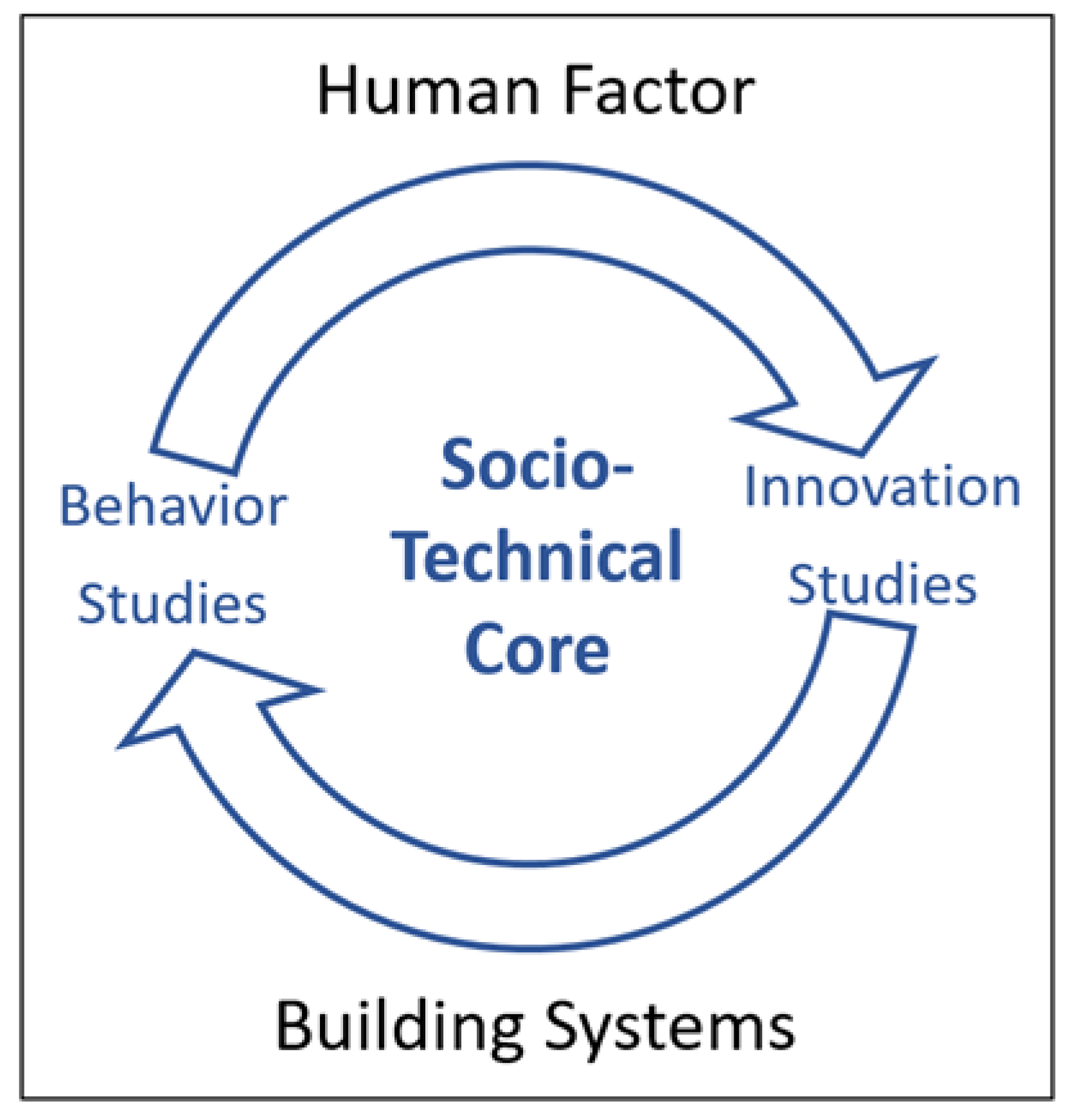
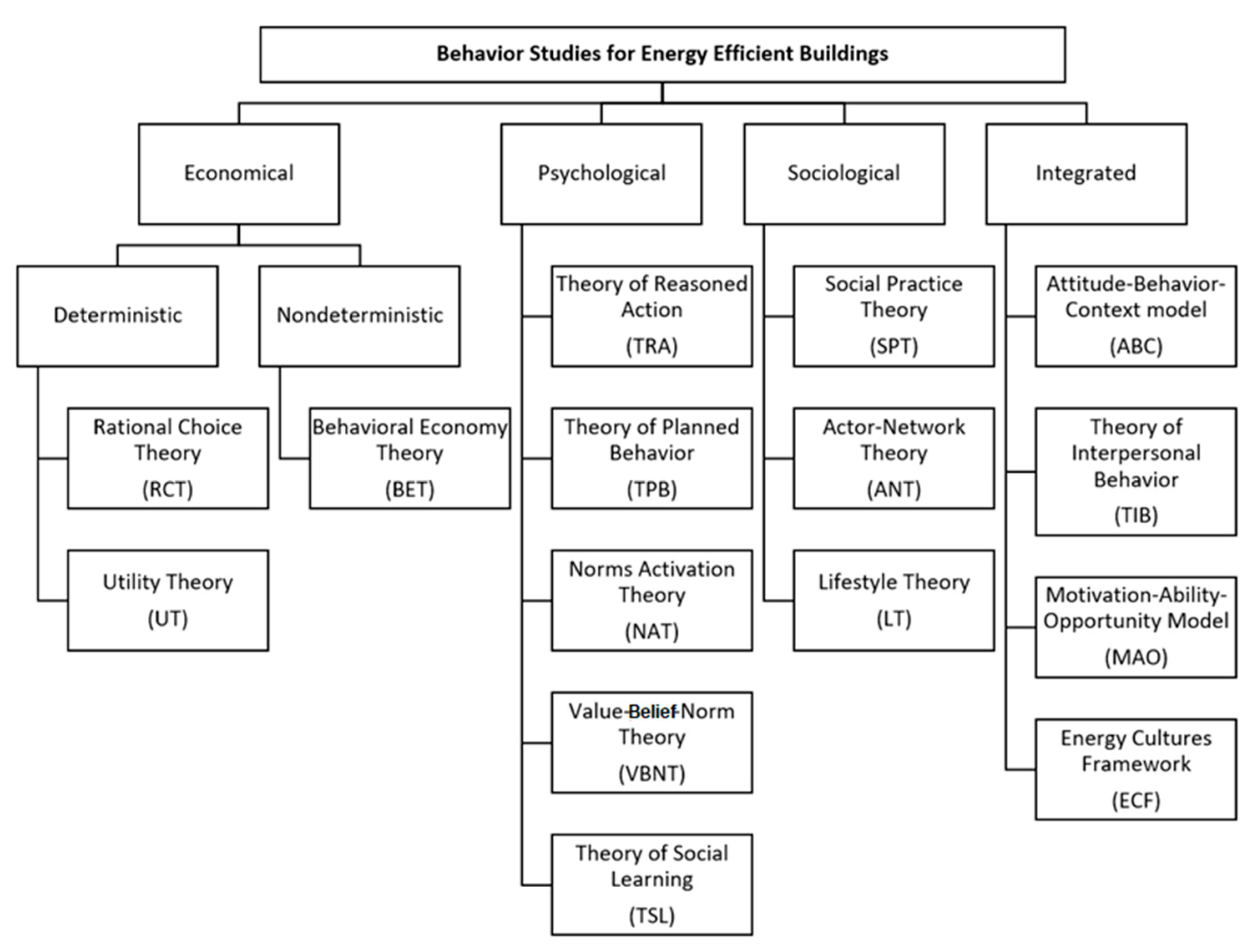

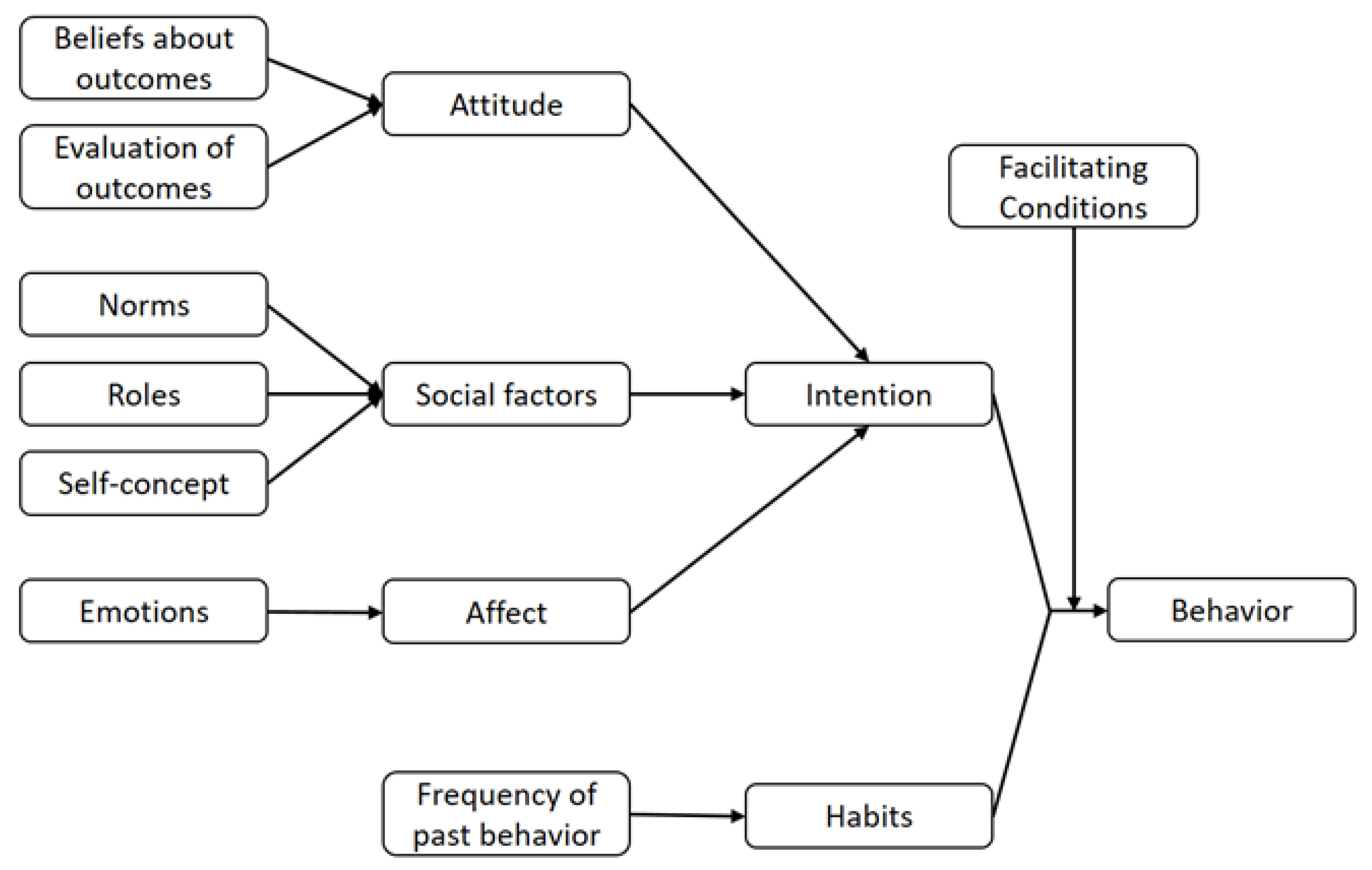
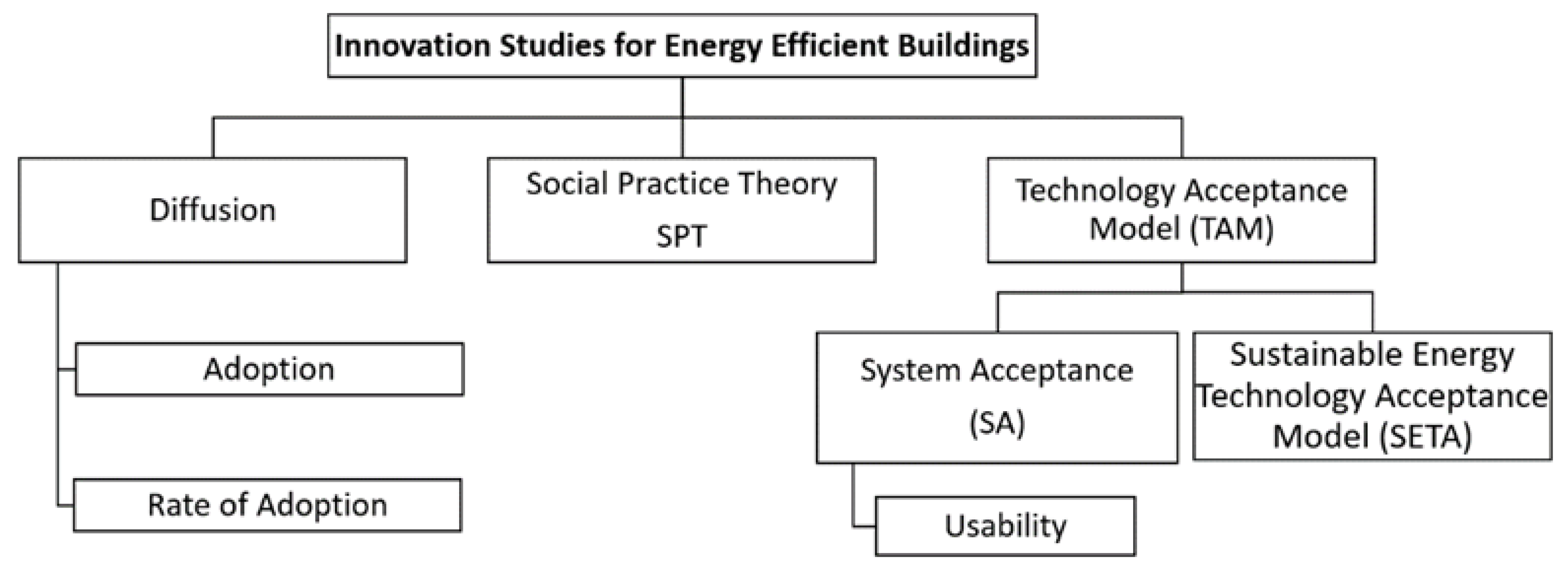
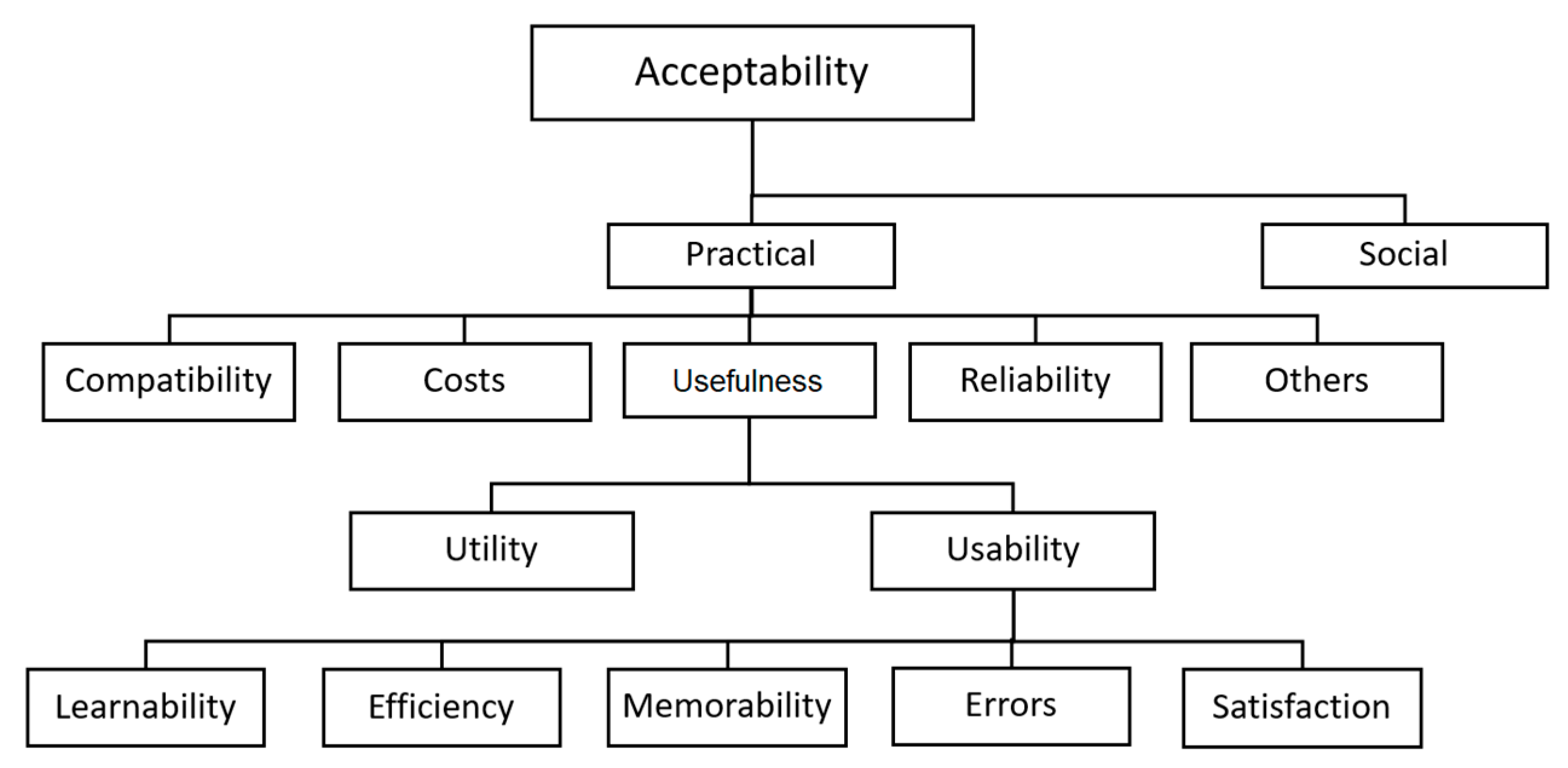


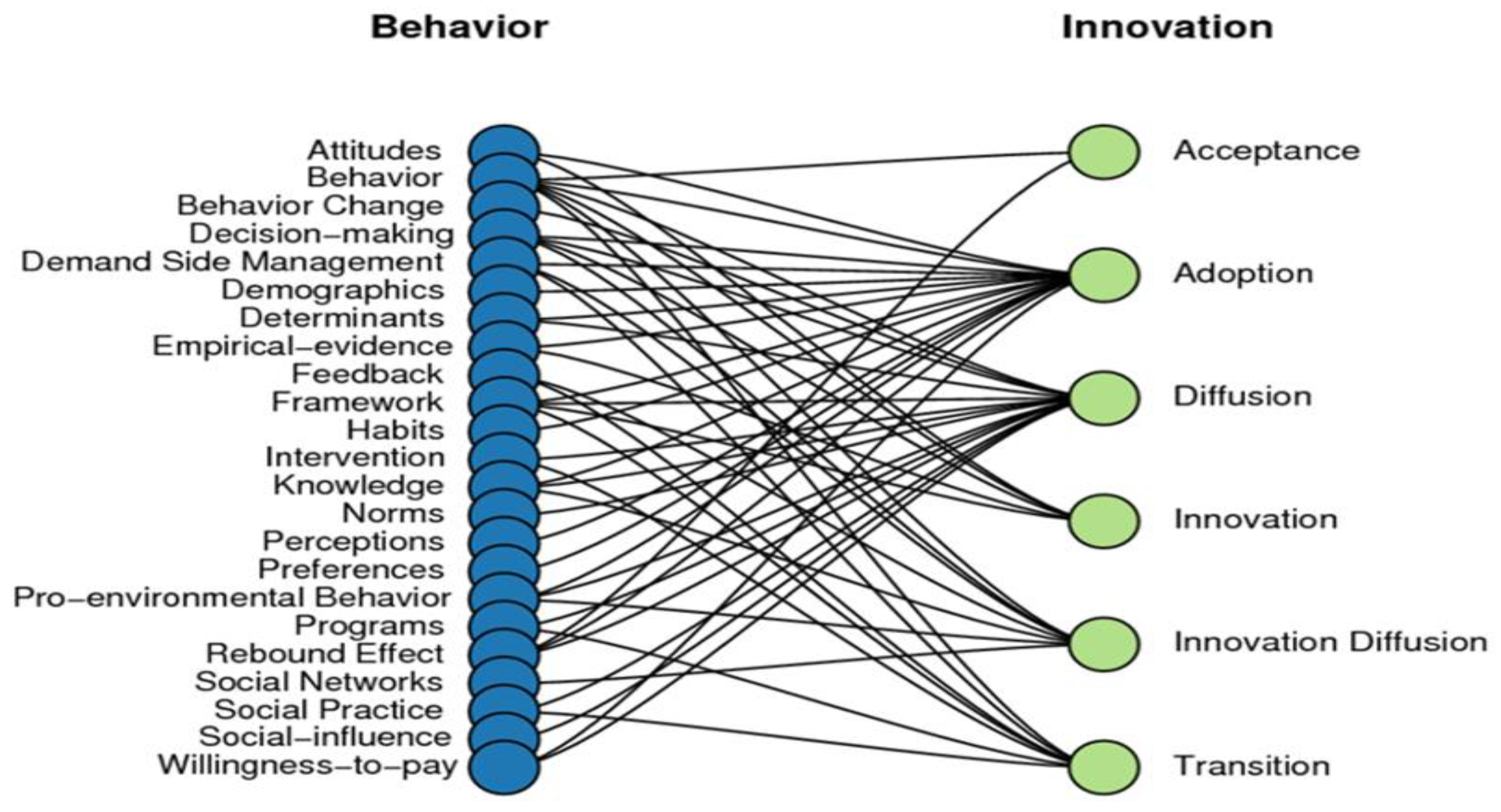
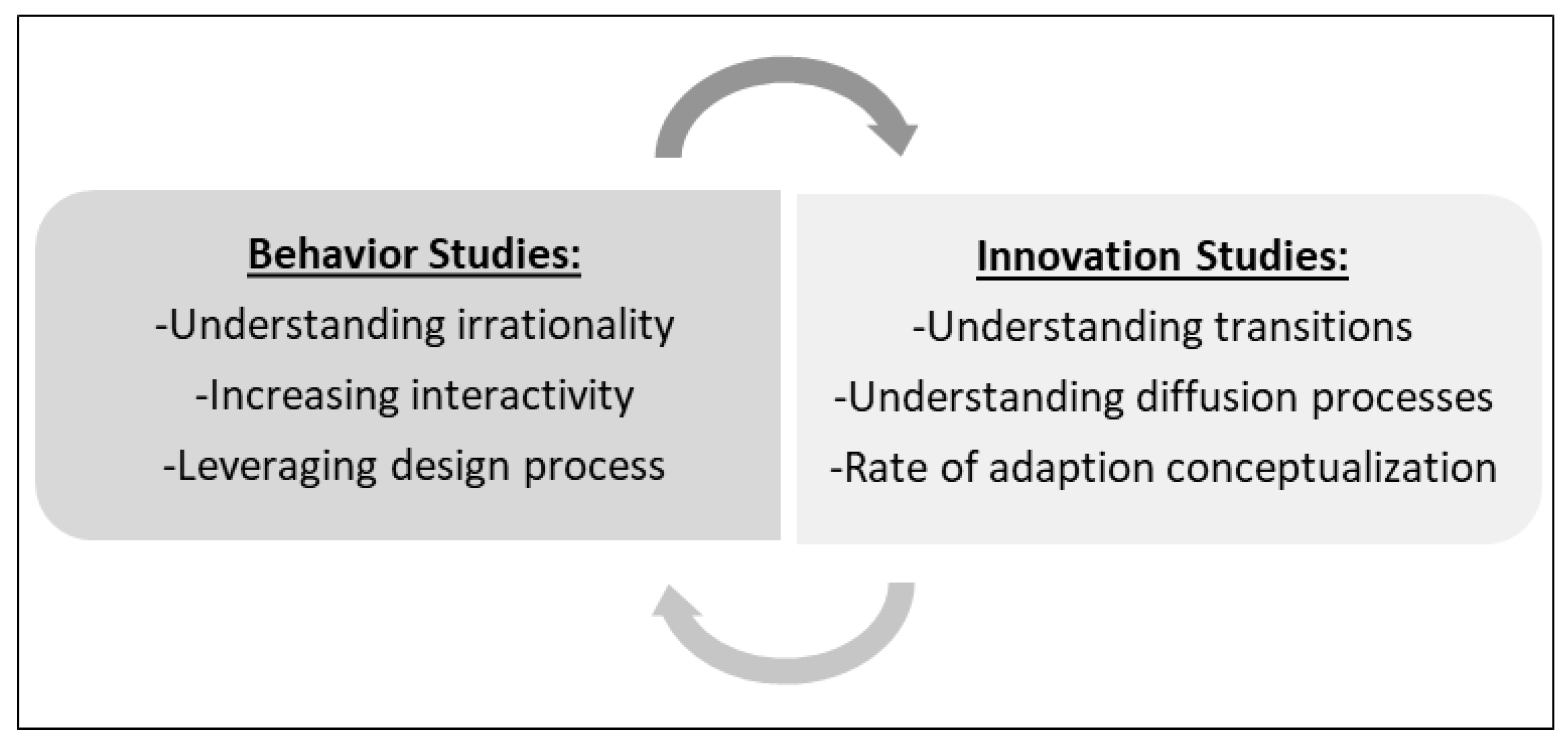
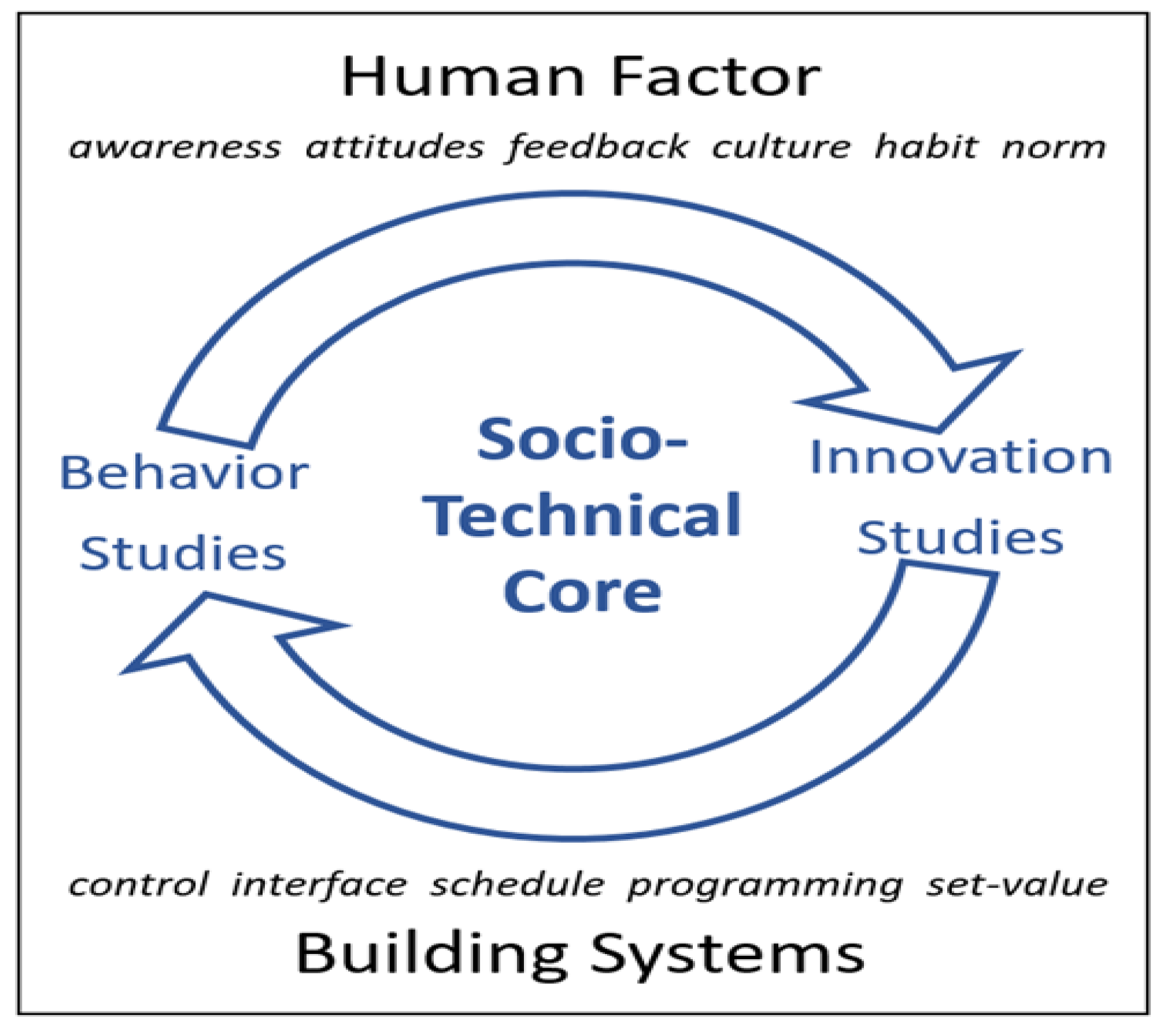
| Branch | Theory and Models | Important Concepts | References |
|---|---|---|---|
| Deterministic Economic Approaches | RCT, UT | rational choice, utility, desires, beliefs, evidence, benefit, outcome | [26,27] |
| Nondeterministic Economic Approaches | BET | behavior, desires, beliefs, attitude, value, resource constraints, knowledge, perceptions, contextual factors, rewards, feedback | [28,29,30] |
| Psychological Approaches | TRA, TPB, NAT, VBNT, TSL | attitude, norms, value, intention, evaluative beliefs, normative believes, motivation to comply, perceived behavioral control, awareness of consequences, ascription of responsibility, learning | [9,31,32,33,34,35,36,37,38,39] |
| Sociological Approaches | SPT, ANT, LT | practice, convention symbols, culture, performativity, routine, network, agents, lifestyle | [40,41,42,43,44,45,46,47,48] |
| Integrated Approaches | ABC, TIB, MAO, ECF | attitude, context, beliefs, norms, values, legacy, policy, habit, facilitating conditions, social factors, affective factors, motivation, ability, opportunity, lifestyle, system thinking, culture | [9,13,49,50,51] |
| Branch | Theory and Models | Important Concepts | References |
|---|---|---|---|
| Diffusion | DT | diffusion, adoption, rate of adoption, communication channels, social system | [12,54,55,59,60] |
| Social Practice | SPT | routinized practices, everyday life, transitions, patterns of meaning, competence, materials | [42,43,61,62,63,64,65,66,67] |
| Technology Acceptance | TAM | perceived usefulness, perceived ease of use, acceptance, usefulness, usability, technology attributes | [68,69,70,71,72] |
© 2018 by the authors. Licensee MDPI, Basel, Switzerland. This article is an open access article distributed under the terms and conditions of the Creative Commons Attribution (CC BY) license (http://creativecommons.org/licenses/by/4.0/).
Share and Cite
Keskin, C.; Mengüç, M.P. On Occupant Behavior and Innovation Studies Towards High Performance Buildings: A Transdisciplinary Approach. Sustainability 2018, 10, 3567. https://doi.org/10.3390/su10103567
Keskin C, Mengüç MP. On Occupant Behavior and Innovation Studies Towards High Performance Buildings: A Transdisciplinary Approach. Sustainability. 2018; 10(10):3567. https://doi.org/10.3390/su10103567
Chicago/Turabian StyleKeskin, Cem, and M. Pınar Mengüç. 2018. "On Occupant Behavior and Innovation Studies Towards High Performance Buildings: A Transdisciplinary Approach" Sustainability 10, no. 10: 3567. https://doi.org/10.3390/su10103567
APA StyleKeskin, C., & Mengüç, M. P. (2018). On Occupant Behavior and Innovation Studies Towards High Performance Buildings: A Transdisciplinary Approach. Sustainability, 10(10), 3567. https://doi.org/10.3390/su10103567





